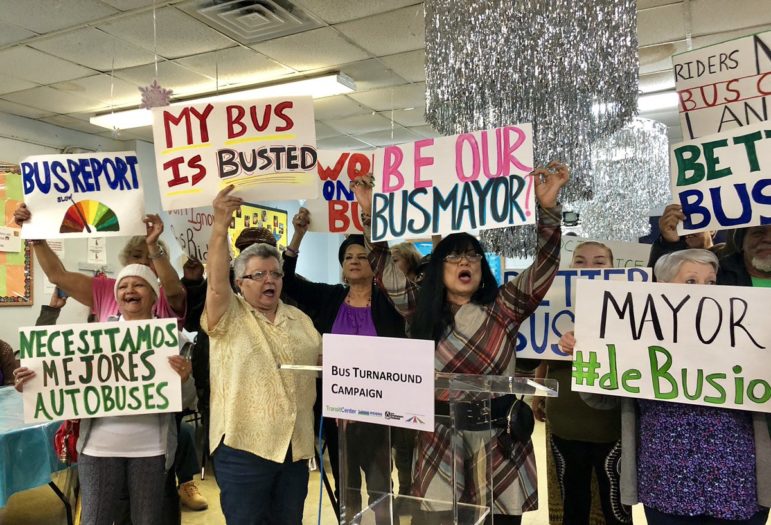
Jeanmarie Evelly / City Limits
Members of the East Side House Settlement’s Melrose Senior Center rallied with Riders Alliance, calling for the city to improve bus service.
In 2016, Bronx resident Alba Quinn suffered a fall that left her reliant on a walker to get around for nearly the next three years. During that time, Quinn, now 59, found it difficult to take the subway, since a majority of stations lack elevators and she couldn’t walk up stairs. When she did take the train, the crowded platforms made her nervous that she might fall, so she started taking buses to get around.
“Very quickly I found out the bus system is a lot worse than our poorly run train system,” Quinn says, describing how she would often wait for long stretches at the bus stop during snow and other inclement weather, without a place to sit or a shelter to stand under.
“I found myself waiting for a bus in these conditions for over 40 minutes, and just wanting to cry because I just did not have it in my budget to hop in a cab,” she says. “I did not go out, and became deeply depressed.”
Quinn’s story is one of several included in a new, bilingual book released by the transit advocacy group Riders Alliance on Thursday, which details the experiences of Bronx seniors as they traverse the bus system. Since buses are handicap-accessible, aging residents rely on them heavily—seniors make up 12 percent of the city’s bus riders, compared to 8 percent of subway riders, according to the comptroller’s office—and slow, unreliable service can make it difficult for them to participate in public life.
With the city’s senior population growing—the number of older New Yorkers is projected to increase to 1.4 million by 2040—Mayor Bill de Blasio’s administration has increased funding for aging services by more than 58 percent, according to Riders Alliance. But without efficient bus service, older residents can’t get where they need to go in order to stay active and ward off social isolation, the organization argues.
“This is in direct opposition to Mayor de Blasio, who is adding more funds for these programs,” says Riders Alliance organizer Stephanie Burgos-Veras. “Our seniors often struggle to be seen, heard and included, and it seems that their preferred mode of transportation, which is the buses, are also being ignored.”
The group, which has been campaigning for better bus service along with other transit advocates as part of the “Bus Turnaround Coalition,” is specifically calling for the de Blasio administration to add 100 miles of bus lanes over the next five years, increase police enforcement of existing bus lanes to make sure the routes are clear, expand the use of transit signal priority to speed up travel time and install shelters at every city bus stop.
While the MTA released its own plan this past spring to fix the city’s sluggish bus network, the Department of Transportation controls the city’s streets, bus stops and traffic lights. De Blasio also released a bus plan last year, in which he announced he would expand the use of Select Bus Service to 21 new routes—but the MTA has since halted the expansion of SBS until 2021 as part of its budget-cutting measures.
“The mayor controls the three S’s: our streets, our sidewalks and the signals,” Burgos-Veras says. “Right now, the Select Bus Service program has been discontinued, so right now really the city is doing absolutely nothing on improving buses for our seniors or for our millions of riders.”
The mayor’s office and the DOT did not immediately respond to requests for comment Thursday.
Riders Alliance’s newly published book, titled “Places to Go: How Seniors Centers are Hurt by Poor Bus Service” includes anecdotes from more than a dozen seniors and staff members at the East Side House Settlement’s Melrose Senior Center in the South Bronx.
They include stories of members being late to doctor’s appointments and senior center programs because of slow bus service, seniors with canes struggling to stand while waiting at bus stops without seating or a shelter, and one woman who described how she sometimes has to wait for several buses to pass her by because they’re all too crowded to fit more passengers.
“At times I feel powerless when I stand at my bus stop to see bus after bus pass and not stop because it’s too crowded. I’ve waited nearly an hour for the the BX15 and Bx19 to arrive to come to the Senior Center,” Armando Roman, 76, says in the report.
“Whenever I see a bus, I try my best to run for it because I have no idea how long the next bus will take,” describes 67-year-old Genaro Guerrero. “I have a knee prosthesis, so I can’t really run very fast, so I wave my hands and yell in hopes that the bus driver will kindly wait for me, but often they take off and I’m left to wait outside without any protection during the changing seasons.”
Eva Gary, 74, recounts how she recently started using a wheelchair, making her commutes even more difficult—especially when the bus is too crowded to accommodate her and her chair.
“The Bx15 is extremely infrequent and often I am turned away because there is no room for me to get on the bus, it’s embarrassing,” she says. “Just because I’m a senior in a wheelchair that doesn’t mean I don’t have places to go.”








One thought on “Mayor’s Senior-Friendly Initiatives Undercut by Poor Bus Service, New Report Says”
The local buses have always been the lowest priority of the MTA. Andy Byford is at least trying. The MTA redesign of the SI Express Bus network is having it’s problems but Byford has been very involved and responsive.
The local bus networks are a mess. Redesigning them is going to be difficult. The Bronx is being done first, then the other boroughs.